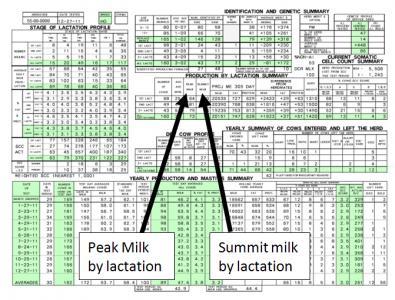Using Peak and Summit Milk to Evaluate Your Dairy's Management Programs
Using Peak and Summit Milk to Evaluate Your Dairy's Management Programs
Using records and the summary of data collected from your dairy herd is critical in helping you improve the overall management and profitability of your herd. This article continues the series on explaining how to use information found on your DHI sheets. This article will review how to use Peak Milk and Summit Milk found on the second page of your Herd Summary sheet (DHI-202).
What is Peak Milk?
Peak Milk is the highest daily milk production for a test day prior to 150 days in milk. Peak Milk is determined once a cow is 100 days in milk from available test day milk production data for the current lactation and, if necessary, is updated until she is 150 days in milk. Peak Milk can occur before 100 days in milk but will not be calculated until this time point. For each lactation group of cows (i.e. 1st, 2nd, 3rd+, and all ages), the Peak Milk is averaged within each group of cows and reported on the DHI-202 summary.

Importance of Peak Milk
From records of 7 Western Canadian herds (14,000 records in the data set), mature cows peaked around 8 weeks into milk and first-calf heifers peaked within 14 weeks . For every pound of milk higher a cow peaks, she produces 200 to 250 lbs more milk over the entire lactation. For example, if we can improve Peak Milk production by 4 lbs, these cows could produce 800 to 1000 lbs more milk over this lactation. Lactation curves for heifers are more persistent, in other words they hold their peak production longer than mature cows. Values for Peak Milk by lactation number are shown in the table for Holstein and Jersey herds enrolled in DHI through DRMS.
Table. Peak and Summit Milk production for Holstein and Jersey Herds
|
|
Holstein Herds |
Jersey Herds |
|
Number of herds |
5982 |
337 |
|
Rolling Herd Average |
24386 |
15809 |
|
Peak milk First Lactation Second Lactation Mature Cows |
80 100 108 |
55 66 71 |
|
Summit Milk First Lactation Second Lactation Mature Cows |
76.2 95.5 102.8 |
51.8 63.3 68.4 |
|
Data represent all herds on DHI test 5-2024 through DRMS |
||
Calculate Peak Ratios
Using your own records, a peak ratio can be calculated. Peak ratio is calculated by:
![]()
Generally, first-calf heifers peak 75 to 80% of mature cows peak production.
If your herd has a lower peak ratio than 75%, your heifers may not be peaking as well as expected. Areas that should be reviewed include
- Are heifers calving at the expected size and weight,
- Are freshening heifers having problems transitioning into the herd,
- Are there numerous heifers that are just “poor doers” and are candidates for culling (may reflect genetics, high somatic cell counts, or heifer feeding and management programs).
If the peak ratio is higher than expected, mature cows are not peaking in milk production. Possible areas to investigated include
- Are cows calving with the appropriate amount of body condition (not too fat or thin- Body condition score of 3.0-3.25),
- Are transition programs around calving working properly so that cows are eating well at and after calving to prevent large losses in body condition (i.e. preventing milk fever, ketosis, metritis, and displaced abomasum in pre-fresh and fresh cows) (less than 0.5 points of body condition score in first 60 days in milk)
- Are high quality forages provided after calving, and
- Do diets fed pre-fresh and after calving contain the appropriate amount of energy.
If the Peak Milk for second lactation cows is lower than expected but mature cows are peaking appropriately, these younger cows may be experiencing sophomore slump. During their first lactation, first-calf heifers need adequate amounts of energy and protein for milk production, growth, and during mid to later lactation to replace used body stores (also known as body condition). If they are not provided adequate amounts of energy during mid to later lactation, they will use available nutrients for milk production and growth and will not regain adequate amounts of body condition. Body fat stores are necessary during early lactation since cows cannot eat enough to support their energy needs and rely on these stores to provide energy for milk production. Thus, these cows do not peak as high and hold that peak as well as if they had the appropriate amount of body condition at calving which they can use during early lactation. Another possibility is that these cows have clinical or subclinical metabolic related disorders (i.e. ketosis, metritis, and displaced abomasum) which limit intake and increase use of body condition for purposes other than milk production.
What is Summit Milk?
Summit Milk is calculated by averaging the two highest milk weights for a cow for the first three test days in a cow’s lactation. For each age group, the values are averaged for all cows that meet these criteria. This value is closely correlated to overall lactation performance. Therefore, as Summit Milk increases, overall lactation milk production increases.
Any decreases seen in Summit Milk could reflect (1) changes needed in feeding and management programs to increase energy, protein, or water intakes, (2) effects of heat stress, (3) poor cow comfort, (4) disease issues such as clinical and subclinical mastitis, or (5) in first-calf heifers, problems associated with heifer-raising programs.
Author: Donna M. Amaral-Phillips, Ph.D.
